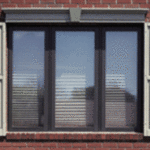Shutters are the original storm window covering. They have been around for centuries. When bad weather loomed, the shutters were closed and latched. The windows inside were then closed. Storm debris hit the shutters, thus saving the window. It was easier to replace a shutter than a glass window pane.
Today, they still serve their purpose. Some are merely decorative. These are easily identified by looking at the windows and the house carefully. If the shutters will not cover the window when closed, or are fixed to the house so they cannot move, they are decorative.
I used shutters in my home. I found shutters at garage sales, flea markets, junque shops and used building supply stores. I built closet doors, shelves and an enclosure for my air conditioner’s condensing unit.
Instead of spending time and money looking for shutters, which are becoming scarce in my area, I started looking for information to build my own.
I found there are two basic types- fixed and adjustable. I’ve built both for fun. Some people find the fixed easier to build, I like the adjustable. Let the project dictate which you need. For outside projects such as a shade for a condensing unit, the fixed is better. To shade inside windows, even those in an RV, (which I built on a dare), the adjustable is better. Let in light by raising the adjustment rod or close the louvers to darken the room.
Make them from PVC lumber or wood. The species of wood is up to you. PVC will not rot outside, mold or be eaten by bugs. If using it around a condensing unit, screen material should cover the fin area. The heat will dry wood out and make it crack; it will warp the PVC.
You will need:
- · General woodworking tools
- · A jig for movable or fixed shutter louvers
- · Basswood louvers, or you can make your own with hand planes or router bits with different woods
- ·:
Study different magazines, books and online sites for the design of shutters that best suit your house and style. The shutter frames can be as plain or as fancy as you desire.
Measure the opening where the shutters will be mounted. Make your frame to fit inside the opening, or if they will be outside, measure the area so the shutters will close securely.
Step Two:
Decide how large your louvers will be. Although commercial jigs are available for louvers 1 ¼,” 2 ½” and 3 ½” wide, you can make them any size. A friend of mine, a master woodworker, made a set with curved edges to fit inside his RV’s main window. The louvers are ½” wide and looks amazing. Show off.
Step Three:
Make your frame with mortise and tenon joints. You can also use half lap joints for lightweight frames. The first are not only traditional, they are the strongest joint for frames.
Do not glue your frame together yet.
Step Four:
Follow the instructions on your jig to create the pin placements. You can indeed make your own jig. There are free plans online for adjustable shelf pin placements. Your pin placements will be very close together. Make sure they are placed so the pins are at the center of your louvers.
Step Five:
Make or cut your louvers. The pins will be inserted at the center ends. When you mount them in place, the bottoms will face outward and the tops will face inward.
Dry fit your frame and ensure everything works. This is an exacting job, so take your time. Adjustments at this stage are normal; do not get frustrated.
Step Six:
If everything fits well and is working, carefully take the frame apart and glue the frame joints together. Do not glue the pins- they have to move.
Step Seven:
Paint or stain your shutters. You can certainly paint or stain the louvers before mounting in the frame. Many woodworkers find this easier.
If you are making your louvered shutters from PVC lumber, you can paint or stain it.
Step Eight:
Mount your shutters or use them to build your desired project.
Uses for shutters:
- · Attach the frames together to create a dresser and use baskets for drawers
- ·. Make square, rectangle, round or any shape you wish.
- ·. Basswood is lightweight while other species will make a heavier shutter.
- · Most louvers today are tapered toward each end. This is not mandatory; it works to allow the shutters to close a little tighter and have less overall weight.
- · Make tall shutters, attach hinges and create a custom room screen.
- · The entire shutter does not have to have louvers. You can place louvers in half, the middle or on the side for truly custom looks. As a wall decoration, you can have a bulletin board with a mail holder. Your imagination is the only limit.
You can build any size of shutters you need. Make custom gifts for family and friends.
Source: The author of this article has over 40 years of experience in diverse forms of DIY, home improvement and repair, crafting, designing, and building furniture, outdoor projects, RV’ing and more.




